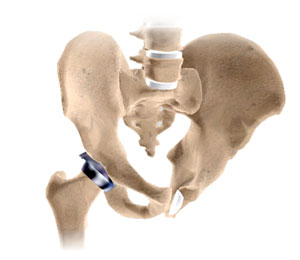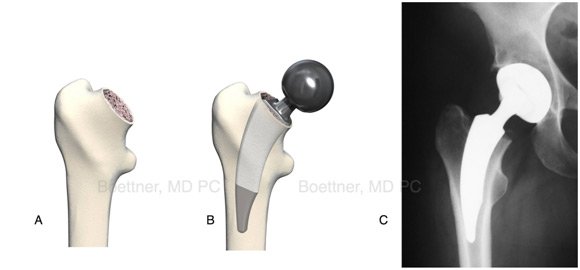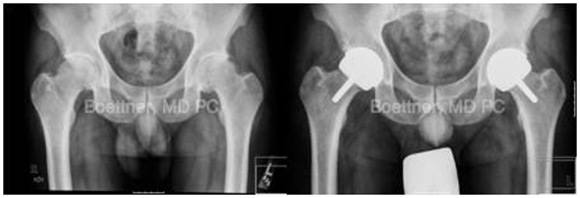
In our practice we see a number of very young patients that need a hip replacement to restore range of motion and treat the pain from arthritis. Often these patients want to go back to high impact sport like running or want to engage in full contact sports like wrestling or mixed martial arts. Also hip replacement today is often performed with short stems and minimal bone violation many of these high impact sports are no longer possible after a standard total hip replacement.

Hip Resurfacing is an interesting alternative for young, and very active male patients. Instead of removing the femoral head, the proximal femur is preserved and resurfaced with a metal implant.

If later revisions are necessary often on the femoral side a standard un-cemented component can be implanted. Because the femoral anatomy is not altered a significant higher proportion of patients is physically able to run and perform high impact sports. In addition because the size of the femoral head remains unchanged the risk for dislocation is significantly reduced. This is especially appealing for rock climber and patients engaging in mixed martial arts.
The following x-ray images show a 46 year old level 4.5 tennis player prior to total hip resurfacing and after the procedure. The patient returned to competitive single tennis in a league after undergoing hip resurfacing with Dr. Boettner.

Because the surgery allows us to restore leg length and a normal configuration of the proximal femur, patients usually regain and improve their range of motion.
The following images show a patient with a very stiff hip prior to hip resurfacing. Because during the procedure Dr. Boettner was able to recreate the head-neck-offset on the femoral side the patient regained normal motion after the procedure.

The following animation will show you how a Hip Resurfacing is performed.
Please discuss the specific risks of a metal on metal hip resurfacing with Dr. Boettner. Because of its bearing components there are some specific risks to this type of surgery:
- Metallic Wear Particles: Aside from the usual and customary surgical risks, metal-on-metal hip implants carry additional risk. The implants are made of an alloy of Cobalt and Chromium (metals). The implants are made to be as frictionless as possible. However, everyday activities will inevitably create some friction and wear which can then result in metallic particles from the implant being released into the tissues surrounding the hip joint. In addition, residual matter from the metal particles may be absorbed and circulated through the bloodstream.
- Pain, Swelling and Inflammation: In certain circumstances metal-on-metal implants may generate more metallic wear particles than usual, causing build-up of metallic wear particles around the hip. This may cause pain, swelling and inflammation around the hip joint. Damage to the tissues around the hip joint is also possible. Revision surgery to remove the metallic wear particles and replace the metal-on-metal implant may be necessary to correct this problem.
- Allergic Reaction to Metal: Some patients have developed an allergic reaction to the metallic wear particles. The symptoms of an allergic reaction can be pain, swelling, and tissue damage. This can occur even when the amount of metallic wear particles is in the normal range. If a patient suffers an allergic reaction, revision surgery is necessary to remove and replace the implant. Currently, there is no proven test to predict the possibility of an allergic reaction.
- Organ Systems Issues: There have been reports of organ systems being affected, when metal ion levels in the bloodstream are higher than expected for a patient with a hip resurfacing implant. Vision, hearing, heart, brain and endocrine functions can also be affected. Some symptoms that have been reported include: blurry vision, loss of hearing, palpitations, loss of concentration, hypothyroidism and decreased kidney functions. If these symptoms develop after surgery, revision surgery to remove the metal-on-metal implant is necessary.
- Fetal Development and Women of Childbearing Age: There is limited data on the effects of circulating metal ions in the bloodstream upon fetal development. Therefore, it is not recommended that women of child-bearing age have a metal-on-metal implant. If a woman of child-bearing age were to have metal-on-metal implant, it is recommended that the amount of metal ions in the blood be checked prior to getting pregnant.
- Patients with small bones and therefore smaller components, patients with misaligned components, women and patients with preexisting metal ion allergies might be at increased risk for above complications.
Although potential benefits of opting for a hip resurfacing over a total hip replacement include: higher post-surgical activity levels and reduced dislocation rates, it has to be assumed that revision rates are higher at 20 years compared to standard total hip replacements.






